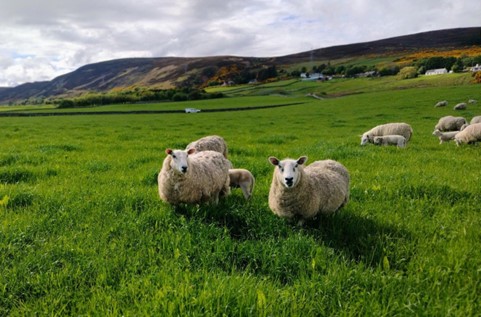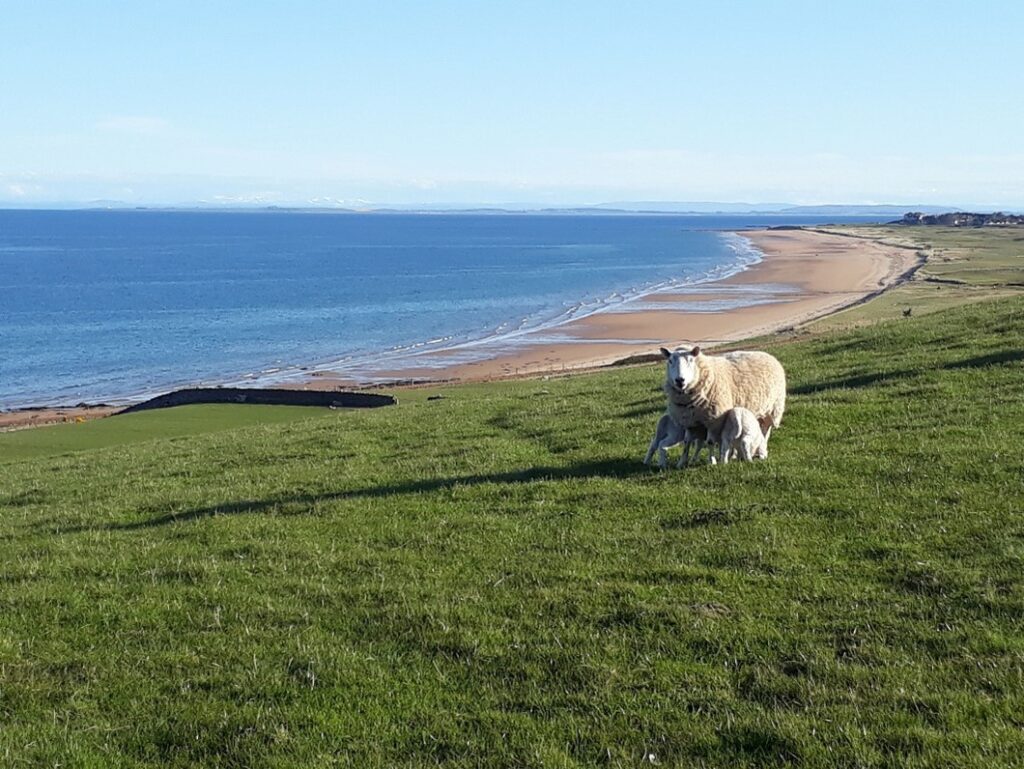Sustainable Sheep Systems – Clynelish Case Study
7 November 2024Jason and Vic Ballantyne farm 125 ha (309 acres) on a secure tenancy at Clynelish Farm in Brora, alongside a further 50 ha (123 acres) on a contract farming agreement 1 mile away, 34 ha of which is hill ground. The business utilises several seasonal holdings including crofts and common grazings to away winter stock. This lets the pasture platform at Clynelish rest during the winter for the ewes returning pre-lambing to optimise nutrition and negate the need for supplementary feeding.
The business runs a flock of 650 maternal bred ewes which are run on an entirely forage based system and lambed outdoors from 18th April for 3 weeks. Lambs are weaned at 11-12 weeks and other than 200 ewe lambs retained for flock replacements, all lambs are sold privately as store lambs in August. The priority for the business is to maintain a prolific, productive ewe which means they are not limited to a specific breed, with genetics stemming from Cheviot, Lleyn, Highlander, Romney, and Aberfield breeds.
The flock was last lambed indoors in 2006, and the use of supplementary concentrate feed was ceased in 2007. The Ballantyne’s have gradually improved the system year on year with an applied focus on increasing winter pasture cover. A rotational grazing system has been in operation for several years, with the whole farm sub-divided into 3 ha paddocks using dykes and electric fencing.
In addition to the sheep, a herd of 100 Aberdeen Angus and Stabiliser cross suckler cows are bulled over a 7 week period with maternal sires to start calving at the same time as lambing. Except for replacement heifers, all progeny is sold store. The cattle play an important role in the leader follower grazing system. Around 40 ‘trading stock’ are run on the contract farmed land.

Breeding
Jason and Vic operate an ‘A’ and ‘B’ flock strategy, with the A flock being bred to maternal sires such as Highlanders and Romneys, while the B flock are mated with a terminal New Zealand Suffolk sire.
Vic says: “We are not breed fussy, we are production and profit based. Every decision we make on inputs must have a return on investment.”
The breeding focus at Clynelish is to continually improve the flock though selection for desirable traits and culling for poor traits. A strict culling policy is adopted using a warning notch in the first instance, to demote the animal to the B flock, then the final strike is a cull notch. With a particular focus on udders, after weaning, an uneven bag receives a cull notch. A 24-hour rule is implemented for any ewe ‘boxing’ her lamb(s), whereby if unresolved by then, lamb(s) are lifted, and she receives a cull notch. The flock are foot bathed three times after marking as they move through gateways to a new paddock. Therefore, few ewes or lambs require treatment for lameness. As a result, the business has developed a robust, sustainable flock of maternal ewes that lamb themselves outdoors and thrive on a forage-based system with few inputs. Their ‘leave well alone’ approach ensures only the most maternal ewe with an excellent mothering ability is retained to future proof the flock.
In the 2024 lambing season, the flock achieved a scanning percentage of 170% and reared 153% with no concentrate feeding and limited supervision. This included 20 ewes rearing triplets. The business has a target of reaching and consistently rearing ~160%. They are confident they can achieve this if they focus on making the right management decisions around nutrition at key times. They will also look at possible mineral deficiencies, particularly selenium which can be attributed to early embryonic death 3-4 weeks following conception.

Lambing to weaning
Lambing commences around 18th April. Vic looks after the ewes carrying twins on one side of the farm, which are run in groups of 45-50 on 3 ha paddocks. On the other side, Jason looks after the ewes carrying singles and triplets and 95 calving cows The singles are run tight in two batches of 100 on 3 ha paddocks of more marginal land to avoid the unborn lambs getting too big and therefore requiring assistance at lambing. The triplets are given priority grazing with plenty cover in front of them, aiming for ewes to rear all three lambs. In 2024, ⅓ of these ewes reared triplets. Others were fostered on to other ewes or lifted and reared as pets. A milk machine was purchased in 2023 which has resulted in much healthier, higher value pet lambs whilst greatly reduced labour. Triplet reared lambs were only 2kg lighter than single lambs and heavier than the twin lambs in 2024.
Around 80% of the flock have lambed within the first 10 – 12 days of lambing, and at this point, any yet to lamb are removed and consolidated into fewer fields for checking. Lambs are marked within one week and thereafter, the mob sizes start to increase to 100. Once the mob is settled, another 100 are added until twins are running in a mob of 220. Ewes are moved to new paddocks every two days, which they become used to very quickly with the cows following on behind.
On the other side of the farm, the leader follower system operates in the order of triplets, then singles, then cows. The cows play an important role in the grazing system, cleaning up the sward which is less desirable to sheep, resetting the pasture for the next rotation and reducing the worm burden. Gimmers are run separately to reduce competition with ewes and to avoid older ewes stealing lambs.
During lambing, Vic checks the twins three times daily and Jason adds an additional check for the ewes under his care where the risk of complication is slightly higher.
Ewes receive no additional supplementation to include forage, concentrates and minerals. Instead, Vic undertakes forage sampling as part of GrassCheck GB. This year, forage analysed at 12 MJ/kg DM ME and 24% protein, providing sufficient nutrition for ewes pre-lambing.
Lambs are weaned around 18th July at 12 weeks of age, weighing 30 kg.
Weaning to tupping
Weaning and grazing plans vary year to year depending on the season, though common practice is to wean lambs early to provide them with the best quality pasture to promote high growth rates. Grass quality and quantity starts to decline by August, by which point, ewes have a lower nutritional requirement, therefore lambs are the priority grazing group.
After the store lambs are sold in the first week of August, the majority of the ewes go to winterings with only 100 remaining at home, including the leaner ewes. With 2024 being a poor growing year, the majority of the ewes were sent off farm to grazings shortly after weaning. On a normal year where grass growth is higher, the dry ewes would follow the cows and calf grazing group.
Ewes are tupped in four management groups, two of these groups at home and two at winterings, with a tup to ewe ratio of 1:50 for 24 days (reducing to 21 days in 2024). When the ewes return home post-scanning, they are managed on a set stocked basis until lambing.
Grazing and soil
The business adopts a ‘ground up’ approach focusing on soil health and sward quality to promote stock performance and maintain a high-quality grazing platform. The pH and nutrient status across the holding is on target, with phosphate and potassium largely recycled by grazing stock. Occasionally potassium has to be topped up following silage production. Full farm soil sampling was carried out in 2020, and the soil nutrient status is routinely monitored to ensure it stays within the optimum range.
The business is not reliant on inorganic fertiliser and as such, has never been an avid user with none being purchased since the price hike in 2022. However, if it was deemed necessary, it would be applied as required.
The business uses low tillage reseeding methods, by spraying off the previous sward after a period of grazing and discing before drilling in the next mix. Grass mixes contain high levels of herbal leys to include plantain, chicory, white and red clover to provide a ‘mixed ration’ for stock. The inclusion of these diverse sward mixes benefits livestock performance by improving the quality of feed offered. They also offer anthelmintic properties to reduce the negative effects of parasites and have a higher tolerance to drought which is predicted to become a more frequent occurrence as a result of climate change.

Work life balance
Jason and Vic demonstrate an admirable work life balance, minimising weekend work. They enjoy time off the farm whether that be holidays, an extended holiday to Vic’s home country - Australia or attending agricultural conferences across the UK where they enjoy meeting up with and sharing ideas with farming peers. They are advocates of the importance of social time and investing in your own health and wellbeing.

| What makes a sheep system sustainable? | At Clynelish |
|---|---|
| Profitability, without reliance on support payments. Continued reinvestment and ability to scale if required to maintain profitability. | Operation of a low input forage-based system incorporating a high level of herbal leys which achieves a moderate output resulting in a profitable enterprise. Breeding for maternal traits that will drive profitability without being pinned down to a specific breed. Management and breeding system focussed on low labour per ewe to reduce labour costs and facilitate continued growth in flock size. |
| Reduced reliance on purchased inputs that may become unavailable or not cost effective. | Matching outdoor lambing with grass growth optimum curve, effective grassland management and robust genetics to remove concentrate supplementation from the system. Focus on soil fertility, diverse herbal leys with a high incorporation of clover to reduce reliance on bagged fertiliser. |
| Sustainable parasite control – limiting development of drug resistance. | Test and treat approach using faecal egg counts (FEC). FEC reduction tests to assess wormer efficacy. Herbal leys to benefit from anthelmintic properties. |
| Maintain and regenerative our greatest asset – soil. | Focus on soil health and diverse swards combined with effective grazing management. |
| Maintain market access and social acceptance. | Proud supporters of lamb, promoting a high standard of animal welfare. Undertaking annual carbon audits in a bid to reduce emissions from farming and maintain a low carbon footprint. |
Hazel Laughton, SAC Consulting
Photo credits: Vic Ballantyne
Related Resources
Sign up to the FAS newsletter
Receive updates on news, events and publications from Scotland’s Farm Advisory Service














